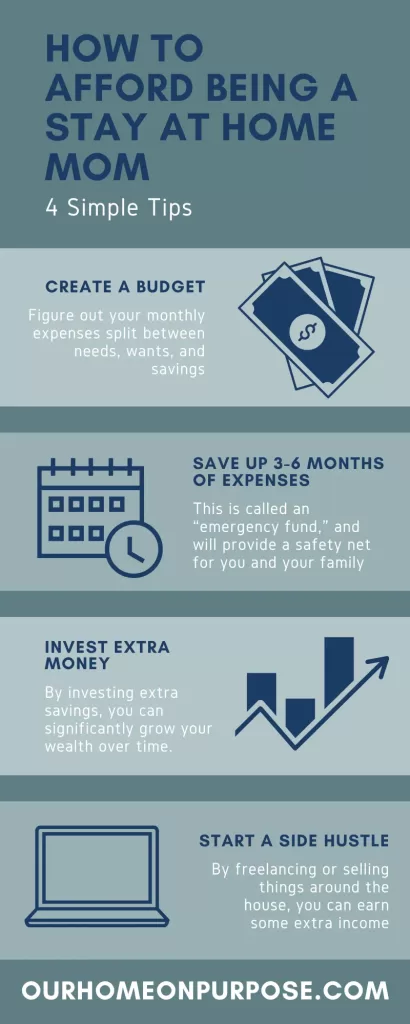Are you wondering how to afford being a stay-at-home mom? If you’re already stay-at-home parent, or are planning to make the shift, you need to have your finances in order.
Whether you’ve been staying home for years, or are just about to start, it’s never a bad idea to reassess your financial situation. Keep reading to learn some budgeting tips to make living as a stay-at-home mom easier, as well as how to get there if you’re still planning on staying home. Let’s get into it.
Note: While we’re focusing on stay-at-home moms, the advice in this article applies just as much to stay-at-home dads, or anybody else looking to stay home with their kids on a single income budget!

Affiliate Disclaimer
This blog includes “affiliate links” where I will receive a small commission if you make a purchase after clicking the link at no additional cost to you. However, all opinions are my own and I only endorse companies that I genuinely recommend.
We participate in the Amazon Services LLC Associates Program, an affiliate advertising program designed to provide a means for sites to earn advertising fees by advertising and linking to Amazon.com. We also participate in affiliate programs with other sites and are compensated for referring traffic and business to these companies.
This sort of income helps make this blog possible, so thank you!
How Much Money Should You Have Saved to be a Stay-at-Home Mom?
This question is crucial when thinking about how to afford being a stay-at-home-mom. This is just as true for potential stay-at-home moms, as it is for those who have been SAHMs for years.
This is because you always want to be confident you’re in a stable place financially when sacrificing a large chunk of your family’s earning potential.
Even if you’ve been a stay-at-home mom for years, take a moment to see if you really have enough saved up for a safety net and future goals. This “safety net” is commonly called an “emergency fund” in the financial world.
So, how much money should be in a stay-at-home mom’s emergency fund?
Generally, most experts recommend an emergency fund of 3-6 months expenses.

This is a good amount to shoot for, as it gives you some security if you come up against any unexpected expenses.
If you don’t have this much saved up, quite frankly, making the move to be a stay-at-home mom may not be the best idea. You may want to continue to work until you have 3-6 months of expenses saved up, and then make the shift to staying at home. This will give you more peace of mind in the long run that you’re in a stable position.
If you find that you’re struggling to save any money even with 2 paychecks coming in, cutting your income even lower probably isn’t the best idea.
If you’re already a SAHM and don’t have this much saved up, consider whether you can get to this number with just 1 income (more on that below). If you’re struggling to make ends meet, going back to work may be the best move financially.
Remember that going back to work doesn’t have to be all or nothing. You could always do something part time, or even find something you could do from home. This can be done temporarily just to help you hit your savings goal.
Of course, we don’t know your situation, so it’s impossible to give blanket advice. However, from a pure financial perspective 3-6 months of expenses saved should be the bare minimum before considering fully becoming a stay-at-home mom.

5 Steps to Creating Your Budget
Below we’ll be covering some budgeting tips that can not only help you become a stay-at-home mom, but help you continue to save and live frugally if you’re already there.
- Calculating Your Income
First, we’re going to calculate 2 versions of your total household income. We’re going to calculate both:
- Your total income if both you and your partner are working
- Your total income if you’re staying at home
If you’re currently working, simply add up both you and your partner’s monthly salary. If you’re not working, estimate what your monthly salary would be if you went back to work. Write these numbers down, then, just write down your partner’s income.
- Calculating Your Monthly Expenses
Next, we’re going to figure out your monthly expenses. Once again, we’re looking for 2 numbers:
- Your total expenses if both you and your partner are working
- Your total expenses if you’re staying at home
While things like rent/mortgage and utilities will likely be the same, things like childcare and even groceries will be rather different. While there may be some guessing involved, try to get these numbers as accurate as possible.

- Deciding Where to Cut Back
These numbers give you an idea of 2 different scenarios.
If you notice the 2 income scenario gives you a lot more wiggle room, then this is likely a better choice financially. This will allow you to keep saving, ensuring a better financial future for you and your family.
If your total expenses are any higher than your total income in the 1 income scenario, you should not be staying home (at least not yet). Even if you have 3-6 months saved up, it will just get drained over time if you’re regularly dipping into it. Ideally you should be adding to that nest egg, not taking from it.
However, if your expenses are only slightly higher than your income, you may still be able to stay-at-home. It will just take some cutting back. Take a look at your expenses again, and see if there’s anything you can save on. This could include:
- Shopping sales
- Canceling subscriptions
- Not going out to eat
- Moving somewhere cheaper
- Paying off debt completely before staying at home
By fully optimizing your expenses, you may be able to make staying at home more realistic! While it will take a lot of sacrifice, decide if staying at home is worth it for you!
- Creating Your Budget
Now that you’ve figured out your income, and optimized your expenses, it’s time to really create a budget. Essentially, this is assigning a role to every dollar that comes in.
Typically, budget advice follows a 50/30/20 rule, where:
- 50% of your budget goes to needs (housing, groceries, utilities, etc.)
- 30% of your budget goes to wants (eating out, new clothes, etc.)
- 20% of your budget goes to saving
While this is a great ratio for some, it can be adjusted for your situation.
Needs are typically the hardest thing to adjust. However, if you’re trying to live frugally, the wants should be cut down as low as possible.
Arguably the most important part is the savings, because this is how you know your budget is really working. Even if it’s only 5% of your income, some money should be going towards savings every month.
Does your income line up with your expenses, allowing some room for saving? If so, being a stay-at-home mom is fully within your reach! Otherwise, it may not be the best idea for you.

- Talking With Your Partner
Of course, whenever making a huge decision like this, talking with your partner is necessary. Especially if you’ve worked out a budget that requires a lot of sacrifice, your partner has to be on the same page as you.
Take some time to think about what you want to say to them. Explain why staying at home is important to you, and why you believe you can make it work. Also, be sure to listen to their needs as well.
At the end of the day, working together is the only way you’ll make this work!

Budgeting to Be a Stay-at-Home Mom in Advance
There are a few things you can do before becoming a stay-at-home mom to make your transition much easier. These mainly involve living well below your means, and saving as much money as possible.
First, try to get your expenses as low as possible before becoming a single income household. Gradually cut out luxury expenses one by one. This will help make the transition much easier than cutting your expenses down significantly overnight.
The great part about doing this is that it will allow you to save more. While the 3-6 months of expenses mark is a good range, you should ideally have much more than this saved up. This will give you an even larger safety net, making it less stressful when those expenses come up.
Finally, make sure your money is working for you. In 2024, the average savings account interest rate is only 0.46%. That’s not a lot. Meanwhile, the S&P 500 stock index has an annualized return of 10.26% since 1957. That’s a lot more.
By investing your money instead of letting it sit in a savings account, you can grow your wealth significantly over time. While we recommend keeping that 3-6 months emergency fund easily accessible, anything extra you save should absolutely be getting invested.

4 Ways to Earn Extra Money as a Stay-At-Home Mom
If you’ve decided to be a full time stay-at-home mom, that doesn’t mean you can’t earn a bit of extra money on the side. Below we’ll be covering just a few ideas to get some extra money as a stay-at-home-mom.
- Freelancing
Ok, to be fair, this is a blanket that covers a ton of different jobs. But the point is, you can turn most skills you have into cash online. By using a platform like Upwork or Fiverr, you can find work as a:
- Writer
- Graphic Designer
- Video Editor
- Tutor
- Fitness Coach
- And More!
Now, this isn’t as easy as signing up and getting a ton of work. It can be tricky to find work on these platforms, but if you have a good profile and stay committed, you can make good money as a freelancer.
- Affiliate Marketing
Again, this isn’t as easy as signing up to an affiliate program and raking in money. You’ll have to build a platform and audience that you can begin showing affiliate links to. But, if you’re willing to build an audience through blogging or social media (Youtube, Instagram, Pinterest, etc.), you can make a good amount of money through affiliate marketing.
- Babysitting/Daycare
If you’re already staying at home with your kids, consider asking around to see if anybody else needs childcare. As you probably know, daycare rates can be incredibly expensive, making someone like you a great alternative.
While taking care of extra kids can be a lot of work, it also allows you to earn some extra money while still staying focused on your kids as well. This is advantageous to things like freelancing which require you to spend a lot of time at the computer instead.

- Sell Things Around the House
Now, this isn’t a long-term job, but selling things you’re not using anymore is a great way to make some extra cash. Depending on what you’re willing to get rid of, this can be an excellent side hustle.
Old clothes is a great place to start using an online platform like Depop or Etsy. You can sell pretty much anything on Facebook Marketplace as well. Having an old-fashioned garage sale is always a great place to start too.
Conclusion
Overall, with the right game plan, you can absolutely figure out a budget that works for you as a stay-at-home-mom. While it will likely take some sacrifice, it may be absolutely worth it for you. As long as you have 3-6 months of expenses saved up, and are still able to put away a little bit of money each month, being a stay-at-home mom is completely within your means.
So, are you a stay-at-home mom now? Or are you planning on being one in the future? Let us know your thoughts in the comments below!
More Life Admin Articles:
- How To Declutter Your Home: Transforming Chaos into Calm
- How to Form Better Self-Care Habits: The Ultimate Guide
- Forming Cleaning Habits that Stick: The Ultimate Guide
- Always Out of Household Essentials? Start Using a Staples Checklist
- How to Use Amazon Photos: Upload and Enjoy Unlimited Photos
- 38 Tips for Managing Life Admin (+ Free Personalized Action Plan!)
- 6 Simple + Effective Ways to Make A Weekly Plan that Works
- How to Write a Mission Statement & Why It’s a Game-Changer
